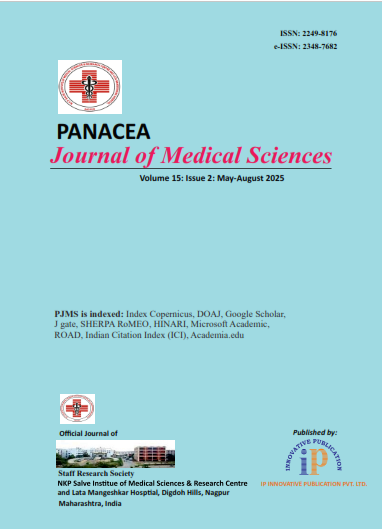Panacea Journal of Medical Sciences
Panacea Journal of Medical Sciences (PJMS) open access, peer-reviewed triannually journal publishing since 2011 and is published under auspices of the “NKP Salve Institute of Medical Sciences and Research Centre”. With the aim of faster and better dissemination of knowledge, we will be publishing the article ‘Ahead of Print’ immediately on acceptance. In addition, the journal would allow free access (Open Access) to its contents, which is likely to attract more readers and citations to articles published in PJMS.Manuscripts must be prepared in accordance with “Uniform requiremen...

Clinical characteristics and outcome of patients hospitalised with Scrub typus -A tertiary care hospital study in Northern India
Page: 404-408
Background: Scrub typhus is a re-emerging but under-reported infectious diseases that leads to significant morbidity and mortality, if failed to diagnose at appropriate time. The objective of the present study was to, know the Clinical Characteristics and Outcome of adult patients hospitalised with Scrub typhus in a tertiary care hospital in a hilly state of Uttarakhand.
Materials and Methods: A total of 68 patients of Scrub Typhus from June 2020 to December 2020 were enrolled in the study. All hospitalised patients included in study were evaluated by detailed history, laboratory tests and outcome in response to treatment with Scrub typhus active antibiotics.
Results: Majority of the cases (54 of 68{79.4 %}) were reported during monsoon and post monsoon season from July to October month. It affects patients of all age group but majority (47 of 68{70.0%}) of patients in our study were young between the age of 18‑40 years. Females were more in number (41of 68, {60.3%}) in comparison to males (27of 68, {39.7%}). Fever in (68 of 68{100%}) was universal complaint associated with severe headache in (18 of 68{26.5%}) patients. Other common symptoms reported were cough & breathlessness in (25 of 68{40.0%}), Nausea and vomiting in (15 of 68 {20%}), abdominal pain in (13 of 68{19.2%}), and altered sensorium in (05 of 68 {8.3%}). GI system involvement in the form of Acute hepatitis with rise in SGOT/SGPT was the most common complication seen in (52 of 68{76.5%}) followed by Respiratory involvement in form of interstitial Pneumonia, interstitial Pneumonia with Pleural effusion, and ARDS was seen in (26 of 68{38.3%}). Renal involvement in the form of AKI with rise in urea and creatinine was seen in (17 of 68{25.0%}) patients. Only 6 (8.8%) of 68 patients received appropriate antibiotics for scrub typhus before admission. Treatment failure, defined by failure to defervescence within 72 hours of scrub typus active antibiotics treatment initiation was noted in 09 (13.2%) patients, out of which 06 (8.8%) patients died in the hospital. No evidence of relapse or reinfection was noted in any patient.
Conclusion: The diagnosis of scrub typhus is challenging due to nonspecific sign and symptoms. A misdiagnosis leading to delayed targeted medical intervention with Scrub typhus active antibiotics (Chloramphenicol, Doxycycline, Azithromycin and Clarithromycin) is the likely contributory factors for high mortality (6 of 68, {8.8%}) in our study.
Article Metrics
- Visibility 13 Views
- Downloads 4 Views
- DOI 10.18231/pjms.v.15.i.2.404-408
-
CrossMark
- Citation
- Received Date March 14, 2024
- Accepted Date March 22, 2025
- Publication Date August 19, 2025